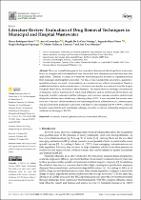Literature Review: Evaluation of Drug Removal Techniques in Municipal and Hospital Wastewater

View/
Author(s)
Rodríguez-Serin, Henry
Gamez-Jara, Auria
De La Cruz-Noriega, Magaly
Rojas-Flores, Segundo
Rodriguez-Yupanqui, Magda
Gallozzo Cardenas, Moises
Cruz-Monzon, José
Date
2022-10Metadata
Show full item recordPublisher
MDPI
Journal
International Journal Environmental Research and Public Health 2022
Abstract
There are several techniques for the removal of pharmaceuticals (drugs) from wastewater; however, strengths and weaknesses have been observed in their elimination processes that limit their applicability. Therefore, we aimed to evaluate the best techniques for the removal of pharmaceuticals from municipal and hospital wastewater. For this, a non-experimental, descriptive, qualitative– quantitative design was used, corresponding to a systematic review without meta-analysis. Based on established inclusion and exclusion criteria, 31 open-access articles were selected from the Scopus, ProQuest, EBSCOhost, and ScienceDirect databases. The results showed that high concentrations of analgesics such as naproxen (1.37 mg/L) and antibiotics such as norfloxacin (0.561 mg/L) are frequently found in wastewater and that techniques such as reverse osmosis, ozonation, and activated sludge have the best removal efficiency, achieving values of 99%. It was concluded that reverse osmosis is one of the most efficient techniques for eliminating ofloxacin, sulfamethoxazole, carbamazepine, and diclofenac from municipal wastewater, with removal rates ranging from 96 to 99.9%, while for hospital wastewater the activated sludge technique proved to be efficient, eliminating analgesics and antibiotics in the range of 41–99%.
Type
info:eu-repo/semantics/article
Rights
info:eu-repo/semantics/openAccess
Language
eng
Collections
- Ingeniería Ambiental [98]

